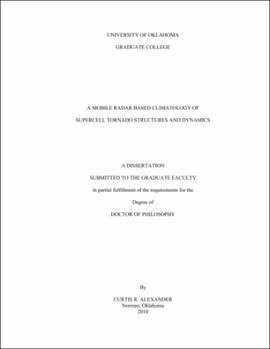| dc.contributor.advisor | Carr, Frederick||Wurman, Joshua | |
| dc.creator | Alexander, Curtis Raymond | |
| dc.date.accessioned | 2019-04-27T21:34:48Z | |
| dc.date.available | 2019-04-27T21:34:48Z | |
| dc.date.issued | 2010 | |
| dc.identifier | 99311091202042 | |
| dc.identifier.uri | https://hdl.handle.net/11244/319059 | |
| dc.description.abstract | Fine-scale-resolution mobile radar observations of supercell tornadoes have been collected by the Doppler On Wheels (DOWs) platform between 1995 and 2010. The result of this ongoing effort is a large observational database spanning over 170 separate supercell tornadoes with a typical data spacing of O(50 m X 50 m X 50 m), updates every O(60 s) and measurements within 20 m of the surface extending to several km above the ground. The data used in this study span 1995-2001 and 69 tornadoes along with about four selected tornadoes from 2003-2004. | |
| dc.description.abstract | Stemming from this observational database is an effort to characterize both the structure and dynamics of the high wind speed environments in and near supercell tornadoes. To this end, a suite of algorithms was developed for and applied to the DOW radar observations for quality assurance along with detection, tracking and extraction of attributes associated with the tornadoes. | |
| dc.description.abstract | The integration of observations across tornado cases in the database produced tornado size and intensity distributions revealing a preferred scale and amplitude for tornadoes produced from mesocyclones of supercell thunderstorms while exhibiting a weak negative correlation between the horizontal scale of a tornado vortex core and the peak intensity. Two horizontal scales are apparent in the clustering of intensity observations with the strongest tornadoes on the smaller scale. The observed intensity distribution is contrasted with traditional damage derived intensity estimates of the same tornadoes from a storm report database to highlight the existing low-bias in supercell tornado intensity estimates. | |
| dc.description.abstract | The vertical structure of the DOW-observed tornadoes is characterized by a much larger variance of near-surface (within 200 m of the surface) tornado wind speeds compared to those associated with the larger scale mesocyclonic flow aloft (over 1 km above the surface) often observed by operational radars. Time and tornado averaged vertical profiles of intensity exhibit a nearly constant value with height in the lowest several hundred meters. Horizontal profiles of velocity and vorticity show a bias towards divergent tornado cores with vertical vorticity maxima in the interior of the tornado core and a departure from solid body rotation. | |
| dc.description.abstract | The evolution of vortex-scale vorticity in most of the tornadogenesis cases also revealed a dominant mode of simultaneous scale contraction through the lowest 1 km layer which has implications for the vertical structure of forcing associated with mesocyclone-associated tornado formation. Layer-averaged low-level (within 500 m of the surface) horizontal angular momentum profiles in weak and the decaying stage of strong tornadoes appear to have non-contracted angular momentum values remaining at larger radii but are removed through lateral advection away from the tornado and/or divergent flow. | |
| dc.format.extent | 250 pages | |
| dc.format.medium | application.pdf | |
| dc.language | en_US | |
| dc.relation.requires | Adobe Acrobat Reader | |
| dc.subject | Doppler radar | |
| dc.subject | Radar meteorology | |
| dc.subject | Tornadoes | |
| dc.title | A MOBILE RADAR BASED CLIMATOLOGY OF SUPERCELL TORNADO STRUCTURES AND DYNAMICS | |
| dc.type | text | |
| dc.type | document | |
| dc.thesis.degree | Ph.D. | |
| ou.group | College of Atmospheric & Geographic Sciences::School of Meteorology | |
